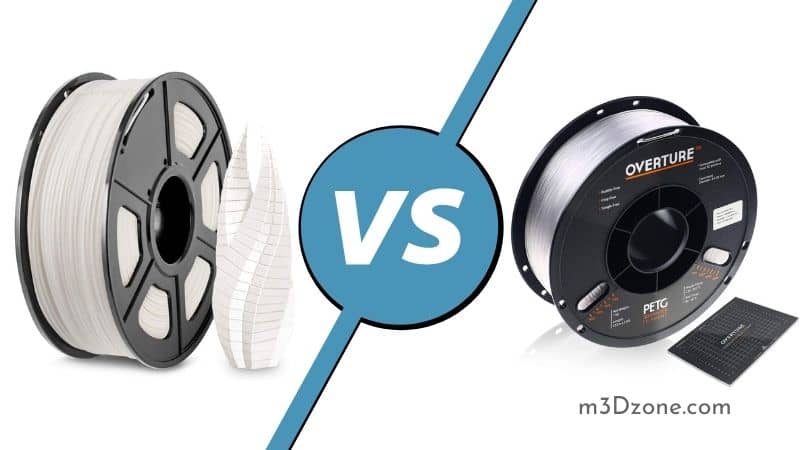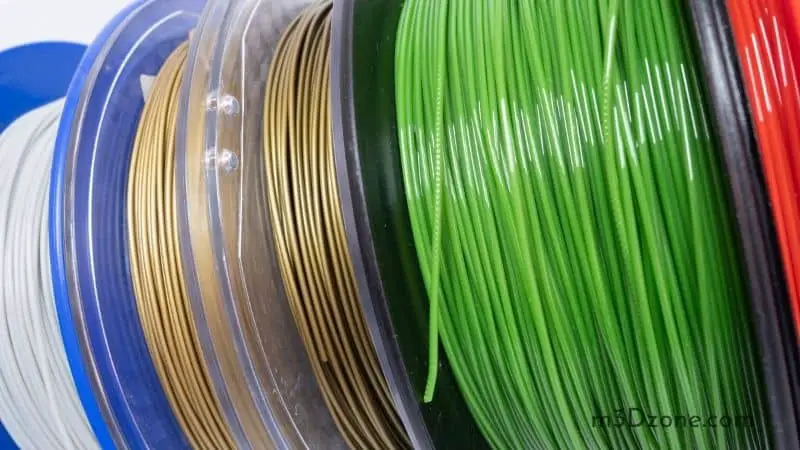When it comes to 3D printing, there are several filaments that people use. The most common filaments preferred for successful prints are either PLA or PETG.

As an Amazon Associate, I earn from qualifying purchases. If you make a purchase after clicking on a link I may earn a small commission at no extra cost to you.
However, a lot of people currently prefer PETG to PLA. But why?
This article shall look at PLA vs. PETG filament to draw their differences and help you decide the ultimate option for your 3D printing needs.
Quick Navigation
- PLA vs. PETG: What Is The Difference?
- PLA vs. PETG – Main Differences
- What Is PETG Filament?
- What Is PETG Good For?
- Is PETG Easy to Print?
- Will PETG Melt in the Sun?
- Is PETG Flexible Material Harder to Print Than PLA? Is It Better Than PLA?
- Is PETG Filament Abrasive?
- Which One Requires a Heated Bed?
- PETG vs. PLA: Final Verdict
PLA vs. PETG: What Is The Difference?
PETG is generally stronger than PLA in regards to tensile strength. PETG is also more durable, has high impact resistance, and is more flexible than PLA filament. This makes it a great option to incorporate into your 3D printing applications.
PETG also has higher heat and UV resistance than PLA, which makes it a better option for outdoor when it comes to strength.
Both PETG and PLA filaments belong to a polyester group of plastics. Like most FDM 3D printing filaments, they are thermoplastics. This implies that they soften above a particular temperature and become solid again after cooling.
This process can be repeated multiple times without degradation of the material quality.
Most PETG and PLA filaments are available in both 1.75mm diameter and 2.85mm diameters.
You might like: PLA vs ABS
PLA vs. PETG – Main Differences
-
Safety
PLA filament is safer than PETG. PLA filament is made from organic sources, and it converts into lactic acid, which cannot cause any harm to a person.
It offers a pleasant and relaxing smell while 3D printing, which makes it better than its counterparts ABS and Nylon in this regard.
PETG filament is safer than other materials like Nylon or ABS, but not than the PLA 3D printing filament.
Users have reported weird smells when using PETG, but that depends on the temperature you’re using and the brand you purchase.
Related: PETG vs Nylon
-
Ease of Printing
Compared to other brands, the unique properties of polylactic acid (PLA) are considered the most suitable filament for beginners because of its ease of printing. When it comes to PLA vs. PETG in regards to convenience, PLA is the best option.
If you are new to 3D printing and run into any problems with print quality or just printer settings, you should stick to PLA.
Many printers have said that PETG is similar in terms of durability to ABS with the ease of printing of PLA.
You need the right print settings, especially retraction settings, for successful prints with PETG.
-
Shrinkage During Cooling
Both PLA and PETG display little shrinkage during cooling. However, the shrinkage rate is less than the other filaments.
The rate of shrinkage of these filaments when cooled is around 0.20-0.25%.
PLA filament shrinkage is hardly visible, while PETG shows more visible shrinkage, but not like ABS. Compared to the other filaments, the ABS shrinkage rate is almost 0.7%, while that of nylon may be up to 1.5%.
-
Food Safety
Both PLA and PETG filaments are considered food-safe, and their prints are commonly used to store food products.
PLA filament is food safe because it is made from the extract of sugarcane and corn, making it an organic filament safe for the food.
3D printing objects are usually meant for single-use products and should not be used twice, given the nature of the layers and gaps in the things.
PETG has excellent resistance to heat, UV light, and different types of solvents which help it to be a safe filament material for food. PETG has also proved to be food-safe for outdoor applications.
-
Pricing
There is a very slight difference in the prices of PETG vs. PLA filaments. PLA is slightly cheaper and also more popular in 3D printing. Although it may be easier to find PLA iN your desired color, while it’s common for PETG filament to be transparent, both filaments come in a broad range of colors.

Related: PLA vs PLA+
What Is PETG Filament?
PETG filament is an extremely tough 3D printing material. It is a special high-strength filament with the ability to achieve solid and sturdy prints.

One of the exceptional features of the PETG filament is its very low shrinkage making it the best option for more extensive flat services.
It is considered a perfect alternative to its counterparts, the PLA and ABS, providing a smoother finish, higher strength, and lower shrinkage.
What Is PETG Good For?
PETG is one of the most common polymers used in 3D printing today. It is used to produce water bottles, food packaging materials, and other everyday plastic items.
PETG plastic has applications in various industries given its resistance to heat, impact, and solvents. It is popularly used to produce packaging items, advertising displays, electronic insulators, and medical packages.

With excellent resistance in low-temperature environments, chemical resistance against bases and acids, minimal deformation when printing, absence of weird smell while printing, and good adhesion between layers, PETG is becoming the most preferred material for 3D printing.
Polyethylene terephthalate glycol is the ideal printing material for producing flexible parts with good resistance to shock-like pressure-clad items, protective items, or food containers.
Is PETG Easy to Print?
PETG filament is usually very easy to print. It doesn’t require an enclosure making it compatible with almost all FDM printers.
PETG material combines the ease of printing with great durability and strength, making it the ideal filament choice for any 3D print.
Will PETG Melt in the Sun?
If you need a 3D print model that will be used for outdoor services or will be exposed to the sun’s direct heat, PETG can withstand heat longer. However, this doesn’t mean that it won’t eventually melt.
PETG printing filaments have a melting point of around 260°C.
The glass transition temperature of PETG ranges between 80-95 °C, and this makes it more efficient in facing hot climates and extreme temperatures compared to its counterparts such as PLA filaments.
This is because of its high strength and heat resistance features, making PETG filaments generally the better option for direct sun. The filament can withstand UV radiation better than other filaments.
If you live in a location where outdoor temperatures get to 40°C, PETG models can stay exposed to direct sun for a long time without getting softer or showing any signs of warping.
Is PETG Flexible Material Harder to Print Than PLA? Is It Better Than PLA?
Both PLA and PETG have the same density. PETG is slightly harder to 3D print than PLA. This is because PLA material is more lenient when it comes to printer settings.
PETG filament and PLA are user-friendly, with PETG being stronger, more durable, and impact resistant. Although you may not technically need a heated print bed to print both filament materials, PETG will require a heated bed for perfect 3D prints while PLA can be printed cold.
One outstanding feature of PETG is its excellent layer adhesion which is typically unmatched and leaves very strong and durable 3D prints. If you need to paint your 3D prints when using PLA, acrylic paint can work extremely well.
When comparing PLA to PETG and how impact resistant the two printing materials are and their adhesive qualities, PLA parts are easier to remove compared to PETG prints which are harder to remove. Printing with PETG produces a more tough material.
Is PETG Filament Abrasive?
PETG, just like its counterparts PLA and ABS, is not abrasive on its own, and you can 3D print for many hours and numerous kilos without seeing anything at all. However, these filaments get more abrasive depending on what they are mixed with, and these already start with pigments.
PETG can be smoothed using fine sandpaper, epoxy resin, and paint. It can also be smoothed with dichloromethane, but it is quite dangerous to obtain.
Which One Requires a Heated Bed?
Both filaments may not technically require a bed. However, for more efficiency, PETG will require a heated bed while PLA filament can be printed cold. 3D Printing PETG requires print surface heat at a temperature range of 70°C – 80°C.
Some users may prefer not to use a heated bed when printing with PETG, given that it doesn’t undergo much warping.
However, it is crucial to have one and set its temperatures similar to what PLA filament uses to ensure that the extruded filament material sticks (PETG sticking).
You are not advised to heat your print surface at higher temperatures above the PETG glass transition temperature (80°C). However, a heated chamber is not required to efficiently print objects in PETG.
Related: Is PLA Conductive?
PETG vs. PLA: Final Verdict
If the physical properties of a filament are an essential consideration for your printing applications, PETG will be the ideal choice for you. On the other hand, if an exact and good aesthetic is required for your printing project, you should go for PLA filament.
This deeper look at exactly how these two popular filament materials differ will help you figure out which is the best option for your 3D printing needs.
Recommended Reading
What Materials Are Used in 3D Printing?
Plastics, metals, and ceramics can produce a diverse range of products. Did you know even soybean oil, chocolate, and wet paper can also make 3D prints?
3D Print Warping. Easy Fixes and Ways to Prevent It!
What is 3D print warping? Warping lies as one of the most common problems you may encounter in 3D printing and very frustrating. Luckily, some measures will help...
What Is FDM 3D Printing?
Fused Deposition Modeling(FDM) and Fused Filament fabrications (FFF) are the same. The FDM or FFF uses additive manufacturing 3D printing technology.
